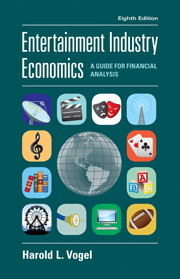Book contents
- Frontmatter
- Contents
- Preface
- Entertainment Industry Economics
- PART I Introduction
- PART II Media-dependent entertainment
- PART III Live entertainment
- Chapter 11 Gaming and wagering
- Chapter 12 Sports
- Chapter 13 Performing arts and culture
- Chapter 14 Amusement/theme parks
- PART IV Roundup
- Appendix A Sources of information
- Appendix B Major games of chance
- Appendix C Supplementary data
- Glossary
- References
- Index
- References
Chapter 11 - Gaming and wagering
from PART III - Live entertainment
Published online by Cambridge University Press: 01 June 2011
- Frontmatter
- Contents
- Preface
- Entertainment Industry Economics
- PART I Introduction
- PART II Media-dependent entertainment
- PART III Live entertainment
- Chapter 11 Gaming and wagering
- Chapter 12 Sports
- Chapter 13 Performing arts and culture
- Chapter 14 Amusement/theme parks
- PART IV Roundup
- Appendix A Sources of information
- Appendix B Major games of chance
- Appendix C Supplementary data
- Glossary
- References
- Index
- References
Summary
It's better to be born lucky than to be born rich.
Perhaps nowhere is the preceding sentiment more appropriately expressed than in gaming and wagering, where kings and queens play amidst snake eyes and wild jokers and horses run for the roses. It has indeed been said that “Whoever wants to know the heart and mind of the earth's citizens needs to understand gambling.” This chapter explores the essential economic features of this fascinating business, for whose services consumers spend more in the aggregate than for any other form of entertainment.
From ancient history
At first
Interest in betting on the uncertain outcome of an event is not a recently acquired human trait. As Berger and Bruning (1979, p. 10) have observed, “archaeologists believe that cave men not only beat their wives, they wagered them as well.” Evidence of mankind's strong and continuing interest in gambling is found in the following historical examples:
In biblical times, the selection of Saul to govern the Hebrew kingdom was determined by lot.
An ivory gaming board was found in the tomb of Egyptian pharaoh Tutankhamen.
Palamedes, according to Greek mythology, invented dice and taught soldiers how to play with them during the siege of Troy. Ancient Greek worshippers played dice games and bet on horse races.
The Romans invented the lottery, and they wagered on the outcomes of chariot races. The emperor Nero was said to be addicted to such racing.
The earliest playing cards were of Chinese origin and were derived from Korean playing sticks. Cards similar to those of today were used by the French in the fourteenth century and are descended from tarot decks used for fortune-telling. France's Louis XV had a deck made of silver, and England's Henry VIII was a notorious gambler.
[…]
- Type
- Chapter
- Information
- Entertainment Industry EconomicsA Guide for Financial Analysis, pp. 407 - 447Publisher: Cambridge University PressPrint publication year: 2010



